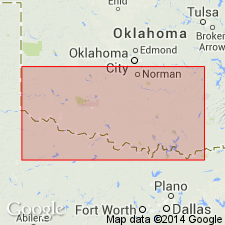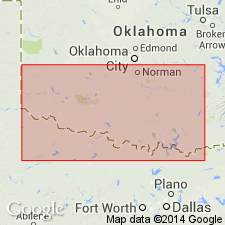
- Usage in publication:
-
- Navajoe Mountain basalt-spilite group
- Modifications:
-
- First used
- Dominant lithology:
-
- Basalt
- Andesite
- Tuff
- AAPG geologic province:
-
- Palo Duro basin
- South Oklahoma folded belt
Summary:
First used; intent to name not stated, and no type locality designated. Origin of name not stated. Report area is southern Oklahoma, where it is present in small areas of: Greer, Comanche, and Kiowa Cos (S. Oklahoma folded belt province); and Tillman and Jackson Cos (Palo Duro basin). Consists of basalt, spilite, andesite, and altered palagonite tuff, at least partly of marine origin, in a subsurface sequence having a drilled thickness of 1,050 ft and a probable total thickness of several thousand ft. Is probably the extrusive equivalent of Raggedy Mountain Gabbro Group (new). Underlies the Middle Cambrian? Carlton Rhyolite Group (revised--rank raised to group), and is intruded by Wichita Granite Group (new, intrusive equivalent of Carlton]. Occurs on outcrop only as inclusions in Wichita Granite Group. Is younger than the Late Precambrian or Lower Cambrian Tillman Metasedimentary Group (new). Navajoe Mountain is shown to be of Early Cambrian? age (535 +/-30 m.y); no isotopic age determination. Geologic map. Generalized sections.
Source: GNU records (USGS DDS-6; Denver GNULEX).

- Usage in publication:
-
- Navajoe Mountain Basalt-Spilite Group
- Modifications:
-
- Named
- Dominant lithology:
-
- Basalt
- Spilite
- Andesite
- Metabasalt
- Tuff
- AAPG geologic province:
-
- Palo Duro basin
- South Oklahoma folded belt
Summary:
Named for Navajoe Mountain in eastern Jackson Co, OK. Though unit does not crop out at Navajoe Mountain, biotite-rich hornfels derived from it occur as inclusions in granite which intrudes group. No type section designated though best exposed in quarry at south end of Navajoe Mountain in NE SW 1-2N-19W. Type well designated as Stanolind 1 Perdasofpy SE NW SW 11-4N-12W, Comanche Co, OK. Penetrated in 11 wells over five counties (Comanche, Stephens, and Kiowa Cos in S. Oklahoma folded belt province and Jackson and Tillman Cos in Palo Duro basin; wells listed in table 11). Occurs as a discontinuous belt along south flank of Wichita Mountains and over a larger area on north flank of Wichita Mountains. Characterized by andesite, metabasalt, and basic hornfels in southern occurrence and basalt, spilite, altered palagonite tuff, and thin interbedded sediments in northern area. Maximum drilled thickness is 1049 ft from type well drilled on north flank of Wichita Mountains; base not penetrated. Total thickness from geophysical evidence is several thousand feet. Unconformably underlies Carlton Rhyolite Group and is intruded by Wichita Granite Group (new); overlies Tillman Metasedimentary Group (new). Petrographic information. Is extrusive equivalent of Raggedy Mountain Gabbro Group (new) and is assigned Early Cambrian? age.
Source: GNU records (USGS DDS-6; Denver GNULEX).
For more information, please contact Nancy Stamm, Geologic Names Committee Secretary.
Asterisk (*) indicates published by U.S. Geological Survey authors.
"No current usage" (†) implies that a name has been abandoned or has fallen into disuse. Former usage and, if known, replacement name given in parentheses ( ).
Slash (/) indicates name conflicts with nomenclatural guidelines (CSN, 1933; ACSN, 1961, 1970; NACSN, 1983, 2005, 2021). May be explained within brackets ([ ]).

